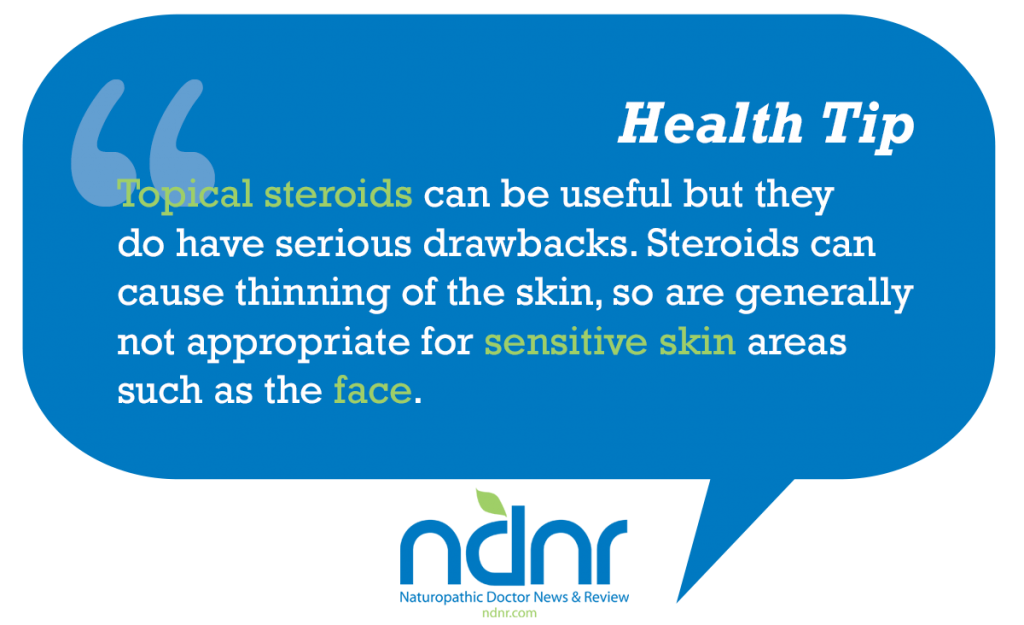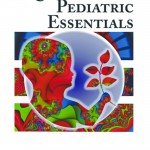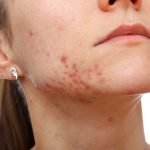Primary Care Management of Atopic Dermatitis: Inside Out and Outside In
Melisa Larson, ND
Jonathan Bell, ND
In traditional naturopathic medicine we are taught to focus on treatment of underlying causes and avoid simply palliating or suppressing symptoms. In our clinical practice we honor this injunction when addressing atopic dermatitis (eczema), while at the same time we believe that palliating symptoms can be a necessary part of management by eliminating obstacles to cure. Thoughtfully palliating symptoms can be helpful as a clinical tool, lead us to be more secure in our diagnosis, and prevent disease progression. This article is written from a mostly clinical view of atopic eczema from our own primary care practice, but it is far from an exhaustive review of the subject. We will describe our thoughts about diagnosing eczema, and offer our most common treatments. Specifically in this article we wish to share our approach to this challenging disorder by integrating conventional tools with traditional naturopathic treatments.
Diagnosis
Eczema is a common diagnosis made in the primary care physician’s office. Typical presentations include local erythema, pruritis, and lichenification. Infantile eczema generally occurs on the scalp, face, and extensor surfaces, and can include more exudation in severe cases. In older children and adults, lesions are more common on the flexural surfaces, hands, and feet, but occurrence can be anywhere there is skin, including the genitals. Of course we need to first differentiate eczema from tinea infections, psoriasis, seborrheic dermatitis, and a host of less common pathologies. It sounds simple enough to distinguish, but at times it can be very challenging. Often eczema occurs with concurrent fungal and bacterial infections, which can confuse diagnosis. Sometimes the very topical treatment we are using complicates the picture by adding a contact dermatitis reaction that worsens the pre-existing eczematous lesion. The clinician needs to be able to differentiate eczema from other pathology in order to “First Do No Harm.”
Pathogenesis
There are various theories on the pathogenesis of eczema. Eczema is not itself considered a type 1 allergic reaction, and there is much controversy in the conventional medical literature as to the role of allergies in eczema. There is, however, an accepted correlation between atopic dermatitis, asthma, and allergic rhinitis – known as the “atopic triad.” In fact, up to 80% of children with atopic dermatitis will go on to develop asthma or allergic rhinitis later in childhood. 1 There is also literature to support the role of genetic mutation associated with eczema. Researchers in the United Kingdom have linked a mutation in the filaggrin gene with high correlation for eczema.2 An interesting study in Copenhagen linked eczema with risk factors that included filaggrin mutation, short body length at birth, and having parents with atopy.3
Treatment:Inside Out
Exploring Food Sensitivities
In clinical practice we often see correlations between and eczema, particularly in children. These are not necessarily the IgE antibody sensitizations used as criteria in most research, but rather slow-onset sensitivities from chronic exposure. The gold standard for examining these food sensitivities in practice is dietary elimination and challenge. While broad elimination diets are useful in adults, this is often not a practical starting point for children. In our practice, we typically choose a few foods to eliminate based on history of food introduction in relation to appearance of symptoms, the child’s general diet, and the mother’s diet if still breastfeeding. The most common offending foods we see in practice include wheat, egg, and dairy, though there is certainly variability from patient to patient. We do offer IgG ELISA testing as an option for patients who are intimidated by full elimination diets, and use these results as a guide for a 2-3 week elimination and challenge.
Reaction to foods generally decreases over time with elimination, so it is important to reintroduce at regular intervals. A challenge every 6-12 months is helpful to establish if the food can be reintroduced into the diet in rotation. If there is an IgEmediated food allergy, IgE testing should be repeated before food reintroduction and often occurs annually in children who are likely to outgrow most food allergies. IgE testing is generally performed through an allergy specialist using either skin prick testing or CAP-RAST (radioallergosorbent test)/ CAP-FEIA (fluorenzymeimmunoassay) of serum samples. Skin prick tests confirmed by double-blind, placebo-controlled food challenges have found 7 foods to account for most food hypersensitivity related to eczema – milk, egg, peanut, soy, wheat, cod/catfish, and cashew.4 While most eczema resolves in early childhood, patients with a history of egg, peanut, or dust mite allergy are more likely to have eczema that persists beyond 5 years of age.5
Naturopathic Therapies
There are countless naturopathic therapies in addition to food elimination used to treat eczema from the inside out, and here we share a few that we commonly employ in our clinic. Naturopathic therapies for eczema generally include herbal and nutrient therapies aimed at healing gastric mucosa, mitigating allergy response, and decreasing inflammation. Probiotics can be useful for treatment of eczema, though research supports their use more for the prevention of infantile eczema when given to pregnant women in the last trimester of pregnancy, and their newborns for the first 6 months after birth.6,7 With the right remedy and a little warning about the possibility of transient exacerbation, homeopathy can be an excellent inside-out treatment for eczema. Remedies such as Graphites, Psorinum, and Sulphur are often thought of for symptom specific treatment of eczema, though we usually treat this chronic condition constitutionally.
Essential Fatty Acids
The use of essential fatty acids (EFAs) is one of our top therapies in the treatment of nearly all patients with eczema. Dietary sources of EFAs such as cold-pressed vegetable and olive oils, avocados, nuts/seeds, and cold-water fish should be emphasized, though a fish oil or flax oil supplement is often needed to get adequate amounts of the omega-3 fatty acids missing in the Western diet. The early theory that a defect in the function of the delta-6-desaturase enzyme contributed to atopic eczema has led much of the research to focus on the use of evening primrose oil, but results have been mixed. Less research has been done on omega-3 fatty acids, though one small pilot study found significant improvement in symptoms using high-dose DHA (docosahexaenoic acid).8 Many of the chewable fish oil products marketed for children are too low-dose to be effective in treatment of eczema. We use liquid fish oil for children starting at a minimum of 1000 mg EPA/DHA.
Symptom Specific Treatment
Eczema can cause significant psychological distress. Chronic pruritis can lead to neurotic scratching and even when the pruritis has been cured, a habitual scratching may continue. Consider this aspect of the disease when treating eczema holistically. This may mean counseling and/or employing the use of psychoactive herbs, supplements, and pharmaceuticals to help mediate psychological suffering. Patients often complain of not being able to sleep when they are dealing with acute episodes of eczema. Along with the antipruritic topicals that you may prescribe, consider treating with pharmaceuticals such as diphenhydramine and hydroxyzine for intense pruritis. These lowintervention antihistamines are relatively safe, will cause drowsiness (a useful adverse effect in this situation), help with the pruritis, and calm the anxiety. Very rarely do we prescribe prednisone for eczema, but certain severe flairs may require this level of intervention to prevent undue suffering.
Outside In: Topical Emollients
Essential to both the treatment and prevention of eczema is keeping the skin well hydrated. Atopic skin has less ability to maintain water resulting in dry skin, pruritis, and the classic itch-scratch cycle seen in eczema. General prevention of dehydration employs the use of lotions, which are rapidly absorbed by the skin. Creams are better at sealing in moisture. Ointments are the best at sealing in moisture, but are generally less comfortable for patients unless the eczema is severe. When patients present with flares, we counsel the use of thick salves or creams frequently and to avoid water-based lotions that rapidly evaporate and can worsen eczema.
Our first-line therapies are topical preparations containing Calendula, Symphytum, and/or Matricaria, and we suggest avoiding fragrance and other additives that can be irritating to sensitive skin. Useful emollient bases include beeswax, cocoa or shea butter, lanolin, and petrolatum. Herbal oils can easily be applied to these vehicles. It is also important to avoid chlorine and frequent bathing, which can dry out skin further, and emollients should always be applied after bathing. Emollients tend to be effective for most eczema if the patient can be disciplined with applying at least 2 times per day. One strategy is to suggest non-greasy lotions and possibly creams during the day, and then the use of salves and ointments at night.
Occlusive and Wet Treatments
Wet treatments include the use of salves and ointments with wet coverings and a cotton wrapping on top, or gloves in the case of hands. When experiencing a severe flare, this is a very effective method of sealing in moisture, increasing absorption of a steroid, boosting the effect of an emollient, and creating a mechanical means of inhibiting scratching.
Topical Steroids
Topical steroids can be useful but they do have serious drawbacks. Steroids can cause thinning of the skin, so are generally not appropriate for sensitive skin areas such as the face. There is also evidence that frequent use of steroids for eczema can cause a resistance pattern, leading to refractory dermatitis. In general, if herbal approaches aren’t effectively controlling the flare, consider starting low on the therapeutic order with hydrocortisone 1%, or mid-level with triamcinolone acetonide 0.1%. For severe scaling and lichenification, most often occurring in adults, higher-level steroids such as clobetasol propionate 0.05% may be needed. Clobetasol should not be used on sensitive or thin skin, but can be helpful on the thickened soles of the foot and, at times, the hands. Generally, high-dose topical steroids should only be applied for flares and for a maximum of 10 days.9 Steroids can also be compounded with the anti-inflammatory and soothing herbs discussed previously. If there appears to be an infective component, you may consider adding Hypericum oil to
your compound. It works fantastically in helping heal excoriated skin.
Topical Calcineurin Inhibitors
Tacrolimus is a topical ointment indicated for refractory eczema. Specifically it inhibits cytokine production and IgE sensitivity by binding T cell receptors. We include it here because of its benefits for suffering patients that don’t respond well enough to natural therapies, and unlike steroids it does not have the risk of skin atrophy and so may be used on the face and neck. However, it is considered second-line treatment to steroids as it has an FDA black box warning about a potential increased malignancy risk (skin and lymphoma) and is not approved for children less than 2 years old.
We feel that naturopathic physicians are well suited to address the complexity of eczema management by this “insideout” and “outside-in” approach. Most importantly, it is imperative that the clinician take steps to reduce severity of eczema and patient suffering, which may involve modulation at the skin level while exploring underlying cause. Not treating eczema effectively and in a timely manner can lead to infection and considerable psychological distress. We can effectively help our patients with eczema by utilizing both natural and conventional treatments.
 Melissa Larson, ND is co-founder of Ballard Neighborhood Doctors, an integrative medical clinic in Seattle. She practices naturopathic family medicine with an emphasis on women’s health and pediatrics. A graduate of Bastyr University, Dr. Larson frequently speaks to healthcare professionals, medical students, and the general public on issues related to pediatric medicine.
Melissa Larson, ND is co-founder of Ballard Neighborhood Doctors, an integrative medical clinic in Seattle. She practices naturopathic family medicine with an emphasis on women’s health and pediatrics. A graduate of Bastyr University, Dr. Larson frequently speaks to healthcare professionals, medical students, and the general public on issues related to pediatric medicine.
 Jonathan Bell, ND is a graduate of Bastyr University. He enjoys practicing primary care medicine in a small Seattle community clinic. His eclectic practice style integrates both alternative and conventional therapeutic tools in a manner that is firmly rooted in naturopathic philosophy. In addition to his clinical practice, Dr. Bell serves as a board member of the Washington Association of Naturopathic Physicians, and occasionally he can be found teaching and continuing to be educated at Bastyr.
Jonathan Bell, ND is a graduate of Bastyr University. He enjoys practicing primary care medicine in a small Seattle community clinic. His eclectic practice style integrates both alternative and conventional therapeutic tools in a manner that is firmly rooted in naturopathic philosophy. In addition to his clinical practice, Dr. Bell serves as a board member of the Washington Association of Naturopathic Physicians, and occasionally he can be found teaching and continuing to be educated at Bastyr.
References
1. Eichenfield LF, Hanifin JM, Beck LA, et al. Atopic dermatitis and asthma: parallels in the evolution of treatment. Pediatrics. 2003;111(3):608-616.
2. Brown SJ, Relton CL, Liao H, et al. Filaggrin null mutations and childhood atopic eczema: a populationbased
case-control study. J Allergy Clin Immunol. 2008;121(4):940-946.
3. Bisgaard H, Halkjaer LB, Hinge R, et al. Risk analysis of early childhood eczema. J Allergy Clin Immunol.
2009;123(6):1355-1360.
4. Burks AW, James JM, Hiegel A, et al. Atopic dermatitis and food hypersensitivity reactions. J Pediatr.
1998;132(1):132-136.
5. Horwitz AA, Hossain J, Yousef E. Correlates of outcome for atopic dermatitis. Ann Allergy Asthma Immunol.
2009;103(2):146-151.
6. Betsi GI, Papadavid E, Falagas ME. Probiotics for the treatment or prevention of atopic dermatitis: a review
of the evidence from randomized controlled trials. Am J Clin Dermatol. 2008;9(2):93-103.
7. Kukkonen K, Savilahti E, Haahtela T, et al. Probiotics and prebiotic galacto-oligosaccharides in the prevention
of allergic diseases: a randomized, double-blind, placebo-controlled trial. J Allergy Clin Immunol.
2007;119(1):192-198.
8. Koch C, Dölle S, Metzger M, et al. Docosahexaenoic acid (DHA) supplementation in atopic eczema: a
randomized, double-blind, controlled trial. Br J Dermatol. 2008;158(4):786-792.
9. Ference JD, Last AR. Choosing topical corticosteroids. Am Fam Physician. 2009;79(2):135-140.









